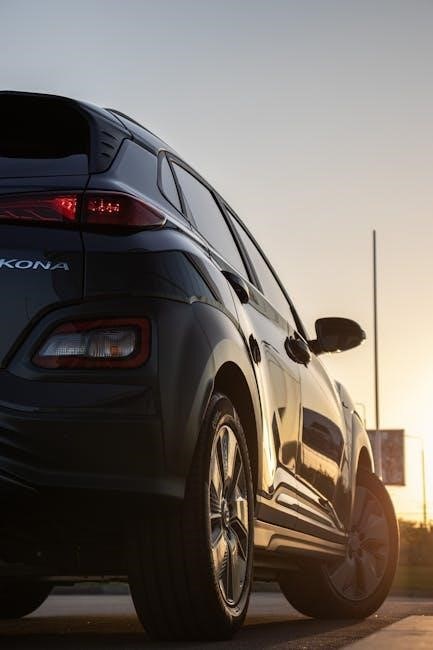The Hyundai Kona Manual provides comprehensive guidance on operation, maintenance, and features of the vehicle. It ensures optimal performance and safety, covering essential details for drivers.
Overview of the Hyundai Kona Manual
The Hyundai Kona Manual serves as a detailed guide for optimal vehicle operation, maintenance, and customization. It includes updates from Hyundai to ensure accuracy and relevance. The manual covers standard and optional features, providing clear instructions for driver assistance systems, infotainment, and safety technologies. Regularly updated, it reflects the latest enhancements, ensuring drivers can maximize their vehicle’s performance and safety. Key sections include troubleshooting, maintenance schedules, and technical specifications, making it an essential resource for Kona owners seeking to understand and care for their vehicle effectively.

Structure of the Hyundai Kona Manual
The Hyundai Kona Manual is structured into sections like Table of Contents, Safety Information, Maintenance, and Troubleshooting, ensuring easy access to essential vehicle information and updates.
Table of Contents
The Hyundai Kona Manual includes a detailed table of contents, organizing information into sections such as vehicle overview, safety features, maintenance schedules, and troubleshooting guides. This structure allows drivers to quickly locate specific topics, ensuring easy navigation through the manual. The table of contents is designed to enhance user experience, providing clear access to essential details about the vehicle’s operation and care. It serves as a comprehensive roadmap for understanding and maintaining the Hyundai Kona effectively.
Important Safety Information
The Hyundai Kona Manual emphasizes critical safety precautions to ensure driver and passenger well-being. It highlights features like child safety locks, seatbelt precautions, and airbag systems. The manual also explains warning lights on the instrument panel, advising prompt consultation of a certified technician if unsure. Regular maintenance and adherence to guidelines are stressed to prevent potential hazards. Hyundai prioritizes safety, and this section underscores the importance of understanding and following safety protocols for optimal vehicle operation and protection.

Key Features of the Hyundai Kona
The Hyundai Kona offers advanced infotainment systems, driver assistance technologies, and Bluetooth connectivity, enhancing comfort, safety, and convenience for a superior driving experience.
Infotainment System
The Hyundai Kona features an advanced infotainment system with a high-resolution touchscreen display, supporting Apple CarPlay and Android Auto. It offers seamless smartphone integration, voice command functionality, and access to various apps. The system also includes a premium audio setup with multiple speakers, ensuring an immersive listening experience. Drivers can navigate effortlessly with built-in satellite navigation and enjoy real-time updates for traffic and weather. This system is designed to enhance connectivity and entertainment, making every drive more enjoyable and convenient.
Driver Assistance Systems
The Hyundai Kona is equipped with advanced driver assistance systems to enhance safety and convenience. Features include Forward Collision Warning, which alerts the driver of potential impacts, and Lane Keeping Assist, which helps maintain lane position. Blind-Spot Monitoring provides alerts for vehicles in the blind zones, while Adaptive Cruise Control adjusts speed to maintain a safe distance from traffic ahead. These systems work together to reduce driver fatigue and improve overall road safety, offering peace of mind during daily commutes and long trips alike.
Bluetooth Connectivity
Bluetooth connectivity in the Hyundai Kona allows seamless wireless integration with smartphones, enabling hands-free calls and music streaming. To pair a device, navigate to the infotainment system’s Bluetooth menu, search for available devices, and follow on-screen instructions. Once connected, users can manage calls, access contacts, and stream audio through the car’s speakers. This feature enhances the driving experience by providing convenient access to smartphone functions while keeping eyes on the road and hands on the wheel for safer driving conditions.
Maintenance and Servicing
Regular maintenance is essential for the Hyundai Kona to ensure optimal performance and longevity. Follow the recommended schedule every 2 years or 30,000 km for oil changes, tire rotations, and inspections.
Recommended Maintenance Schedule
The Hyundai Kona Manual outlines a detailed maintenance schedule to ensure optimal vehicle performance. Regular servicing is required every 2 years or 30,000 kilometers, whichever comes first. This includes oil changes, tire rotations, and inspections of critical components like brakes and belts. Fluid checks, air filter replacements, and battery inspections are also recommended to maintain reliability. Adhering to this schedule helps prevent issues and ensures the vehicle runs efficiently. Always refer to the manual for specific guidelines tailored to your Kona model.
Oil Change and Fluid Check Guidelines
The Hyundai Kona Manual recommends regular oil changes every 5,000 to 7,500 miles, depending on driving conditions. Use synthetic oil for optimal performance, especially in extreme temperatures. Fluid checks, including engine oil, coolant, brake, and windshield washer fluids, should be performed monthly or before long trips. Always refer to the manual for the correct procedure and recommended fluids. Neglecting these checks can lead to reduced performance and increased wear on vehicle components. Consult a certified technician if unsure.
Tire Pressure and Rotation
The Hyundai Kona Manual recommends checking tire pressure monthly and before long trips. Pressure levels can be found on a sticker on the driver’s side door frame or fuel filler flap. Proper inflation ensures optimal performance, fuel efficiency, and safety. Tire rotation should occur every 5,000 to 7,500 miles to prevent uneven wear. Use the pattern specified in the manual to maintain even tread wear. If irregular wear is noticed, consult a certified technician to address potential alignment issues promptly.

Troubleshooting Common Issues
The Hyundai Kona Manual provides solutions for common issues like warning lights, Bluetooth pairing, and automatic emergency braking sensitivity. Refer to the manual for detailed diagnostic guidance and solutions.
Warning Lights on the Instrument Panel
The Hyundai Kona’s instrument panel features various warning lights that indicate potential issues or system statuses. These lights are designed to alert the driver of conditions such as low tire pressure, engine malfunctions, or active safety features. The owner’s manual provides a detailed guide to understanding each symbol and its corresponding meaning. If a warning light illuminates, it is important to refer to the manual or consult a certified Hyundai technician to address the issue promptly and ensure vehicle safety. Regular checks can help prevent unexpected problems and maintain optimal vehicle performance.
Bluetooth Pairing Issues
If you encounter Bluetooth pairing issues with your Hyundai Kona, ensure your phone’s Bluetooth is enabled and the vehicle’s infotainment system is in pairing mode. Restart both devices and check for software updates. The manual recommends consulting a certified Hyundai technician if problems persist. Proper pairing ensures seamless connectivity for hands-free calls and music streaming. Refer to the manual for detailed troubleshooting steps to resolve connectivity problems efficiently and maintain optimal infotainment functionality.
Automatic Emergency Braking Sensitivity
The Hyundai Kona’s automatic emergency braking system can be adjusted for sensitivity through the infotainment settings. Access the Driver Assistance menu, select Automatic Emergency Braking, and choose from available sensitivity levels. This customization ensures the system operates according to your driving preferences, enhancing safety without unnecessary interventions. Adjustments should be made carefully to maintain optimal vehicle response in various driving conditions. Always refer to the manual for detailed instructions to ensure proper configuration and functionality of this advanced safety feature.

Driver Assistance Technologies
The Hyundai Kona features advanced driver assistance systems, including Lane Keeping Assist, Forward Collision Warning, and Blind-Spot Monitoring, enhancing safety and driving convenience for all road conditions.
Lane Keeping Assist System
The Lane Keeping Assist System in the Hyundai Kona helps drivers stay within lane markings by gently steering the vehicle back into its lane if it drifts. This feature is especially useful during long highway drives, reducing driver fatigue. It can be activated through the infotainment settings under Driver Assistance and adjusted for sensitivity. The system uses cameras to monitor lane lines and provides subtle corrections for a safer driving experience.
Forward Collision Warning
The Forward Collision Warning system in the Hyundai Kona alerts drivers of potential frontal collisions by detecting the distance and speed of vehicles ahead. It uses radar sensors to monitor traffic and provide timely alerts. If a collision is imminent, the system emits visual and audible warnings, encouraging the driver to take evasive action. This feature enhances safety by reducing the risk of accidents caused by distracted or inattentive driving, offering peace of mind on the road.
Blind-Spot Monitoring
The Hyundai Kona’s Blind-Spot Monitoring system uses radar sensors to detect vehicles in the driver’s blind spots. When a vehicle is detected, the system illuminates an indicator light in the corresponding side mirror. If the driver attempts to change lanes while a vehicle is in the blind spot, the system can apply gentle steering assistance to prevent a collision. This feature is available on higher trim levels and can be activated or deactivated through the vehicle settings menu for enhanced driving safety and convenience.

Vehicle Specifications
The Hyundai Kona offers a range of engine options, including a 2.0L and 1.6L turbo, with manual or automatic transmissions. It features front-wheel or all-wheel drive, ensuring versatility and efficiency, while delivering impressive fuel economy and performance capabilities across various trim levels.
Engine Options
The Hyundai Kona is equipped with two main engine options: a 2.0-liter four-cylinder engine and a 1.6-liter turbocharged engine. The 2.0L engine delivers smooth power delivery and is ideal for everyday driving, while the 1.6L turbocharged engine offers enhanced performance with increased horsepower and torque. Both engines are designed to provide a balance of fuel efficiency and responsiveness, catering to diverse driving preferences. Additionally, the Kona is also available as a fully electric vehicle (EV), offering a zero-emission alternative with impressive range capabilities.
Transmission Options
The Hyundai Kona offers multiple transmission options to suit various driving preferences. A 6-speed manual transmission is available for drivers who prefer control. Additionally, an 8-speed automatic transmission provides smooth gear shifts and improved fuel efficiency. For enhanced performance, a 7-speed dual-clutch transmission is also offered, delivering quick and responsive acceleration. These options ensure a seamless driving experience, whether in city traffic or on the highway. The manual also highlights the availability of a single-speed transmission for the electric Kona variant, optimizing efficiency for EV driving.
Fuel Efficiency
The Hyundai Kona offers impressive fuel efficiency across its variants. The 2024 model with a 1.6L turbocharged engine achieves an estimated 27 MPG in the city and 33 MPG on the highway. Hybrid and electric models further enhance efficiency, with the electric Kona providing a range of up to 258 miles on a single charge. Regular maintenance and optimal driving habits can maximize fuel efficiency.Consult the manual for specific recommendations tailored to your vehicle’s configuration and driving conditions to ensure peak performance and cost savings.

Interior and Comfort
The Hyundai Kona offers a spacious and comfortable interior with ample passenger room and cargo space. It features a modern design, ergonomic seating, and advanced infotainment systems for a premium driving experience.
Seating Capacity and Cargo Space
The Hyundai Kona comfortably seats up to five passengers, offering generous legroom and headroom for both front and rear occupants. The cargo area provides up to 19.2 cubic feet of space behind the rear seats, expanding to 45.8 cubic feet when folded. This versatility makes it ideal for daily commutes or road trips, ensuring ample storage for luggage, groceries, or outdoor gear. Practical compartments and clever design elements enhance convenience, making the Kona a practical choice for various lifestyles.
Infotainment and Connectivity Features
The Hyundai Kona features a modern infotainment system with a 7-inch touchscreen display, offering seamless integration with Apple CarPlay and Android Auto. Drivers can access navigation, media, and apps through voice command or intuitive touch controls. The system also includes a six-speaker audio setup for enhanced sound quality. Additional features like USB ports and auxiliary inputs ensure versatile connectivity options, while customizable settings allow for a personalized driving experience, making every journey more enjoyable and convenient.
Customization Options
The Hyundai Kona offers various customization options to tailor the driving experience to individual preferences. Drivers can adjust settings such as steering effort, climate control, and infotainment preferences through the vehicle’s settings menu. Personalization extends to ambient lighting and seat adjustments, ensuring a comfortable and unique environment. Additionally, the manual highlights how to save preferred settings for multiple drivers, enhancing convenience and flexibility. These customization features allow owners to maximize their comfort and enjoyment while driving.

Exterior Design
The Hyundai Kona features a modern, compact design with a sleek grille, LED headlights, and aerodynamic lines. Its exterior is customizable with various color options and wheel designs.
Styling and Aerodynamics
The Hyundai Kona features a modern and stylish exterior design with a unique front grille, LED headlights, and aerodynamic lines. Its compact SUV profile is enhanced by a sloping roofline and sporty accents, ensuring a dynamic appearance. The aerodynamic design reduces wind resistance, improving fuel efficiency and driving stability. Sleek exterior elements, such as chrome trim and optional alloy wheels, add to the vehicle’s sophistication. The Kona’s exterior styling balances practicality and aesthetics, making it a standout in its class.
Color Options
The Hyundai Kona offers a wide range of exterior color options, allowing owners to personalize their vehicle. From bold metallic shades to sleek solid tones, the Kona’s palette includes choices like Ignite Flame, Ultra Black, Chalk White, and more. These colors are designed to complement the vehicle’s modern design, enhancing its visual appeal; Whether opting for a vibrant statement shade or a timeless neutral, the Kona’s color options ensure a unique and stylish presence on the road.
Wheel and Tire Options
The Hyundai Kona offers a variety of wheel and tire options to suit different driving preferences and styles. Available wheel sizes range from 16-inch steel wheels to 18-inch alloy wheels, providing a balance between durability and aesthetic appeal. Tire options include all-season tires for versatile performance and eco-focused tires for improved fuel efficiency. The manual recommends checking the tire pressure regularly, as specified in the maintenance section, to ensure optimal performance and longevity of the tires. This ensures a smooth and efficient driving experience.

Safety Features
The Hyundai Kona is equipped with a comprehensive suite of safety features, including multiple airbags, electronic stability control, and advanced driver-assistance systems like forward collision warning and blind-spot monitoring.
Airbag System
The Hyundai Kona features a sophisticated airbag system designed to enhance occupant safety. It includes front, side, and curtain airbags that deploy during collisions to minimize injury. The system is equipped with sensors to detect impact severity and optimize inflation. Additionally, a rollover sensor activates the side curtain airbags if a rollover is detected. The manual advises against installing rear-facing child seats in front of active airbags and provides guidelines for proper child seat installation. Always refer to the manual for specific instructions on airbag maintenance and deactivation procedures for the passenger airbag when necessary.
Electronic Stability Control
The Hyundai Kona is equipped with Electronic Stability Control (ESC), a system designed to improve vehicle stability and traction. It automatically adjusts engine power and applies selective braking to individual wheels to help maintain control during slippery or uneven road conditions. ESC is enabled by default on startup and works seamlessly with other safety features to enhance driving confidence. For specific driving modes, such as off-road, the system can be deactivated if needed. Always refer to the manual for detailed instructions on using ESC effectively.
Child Safety Locks
The Hyundai Kona features child safety locks to ensure rear doors cannot be opened from the inside, enhancing safety for children. These locks are engaged manually and can be activated or deactivated using controls on the door or through settings in the owner’s manual. Refer to the manual for specific instructions on how to use this feature effectively to prevent accidental door opening during travel.

Warranty and Support
The Hyundai Kona comes with a comprehensive manufacturer warranty, offering coverage for parts and labor. Customer support services include roadside assistance and access to authorized service centers.
Manufacturer Warranty
The Hyundai Kona is backed by a comprehensive manufacturer warranty, designed to provide peace of mind. The basic warranty typically covers the vehicle for 5 years or 60,000 miles, while the powertrain warranty extends to 10 years or 100,000 miles. This ensures protection against defects in materials and workmanship for essential components. Additionally, Hyundai offers a rust perforation warranty for 7 years, safeguarding against corrosion. These warranties demonstrate Hyundai’s commitment to durability and customer satisfaction.
Customer Support Services
Hyundai offers extensive customer support services to ensure a seamless ownership experience; Owners can access a 24/7 customer service hotline for immediate assistance with queries or concerns. Additionally, online support through live chat and email is available for convenience. The Hyundai website provides a wealth of resources, including FAQs, troubleshooting guides, and downloadable manuals. These services are designed to address any questions or issues promptly, ensuring drivers receive the help they need to maintain and enjoy their vehicle effectively.
Service Centers and Dealerships
Hyundai operates an extensive network of authorized service centers and dealerships to provide expert maintenance and repairs for the Kona. These centers are equipped with state-of-the-art tools and staffed by certified technicians. Owners can locate their nearest dealership using the dealer locator tool on Hyundai’s official website. Service centers handle everything from routine maintenance to complex repairs, ensuring your vehicle receives the highest level of care. Additionally, dealerships offer new and certified pre-owned vehicle sales, test drive appointments, and personalized advice to enhance your ownership experience.
The Hyundai Kona Manual is a valuable resource for owners, offering insights into operation, maintenance, and features. It ensures optimal performance, safety, and efficiency, guiding users to maximize their driving experience while adhering to recommended practices for longevity and satisfaction.
Final Thoughts on the Hyundai Kona Manual
The Hyundai Kona Manual is an indispensable guide for owners, offering detailed insights into vehicle operation, maintenance, and features. It emphasizes the importance of regular servicing and proper usage to ensure optimal performance and longevity. By following the manual’s recommendations, drivers can enhance safety, efficiency, and overall driving satisfaction. The manual’s clear instructions and comprehensive coverage make it a crucial tool for maximizing the potential of the Hyundai Kona.
Importance of Regular Maintenance
Regular maintenance is crucial for ensuring the Hyundai Kona’s optimal performance, reliability, and longevity. By adhering to the recommended maintenance schedule, owners can prevent potential issues, reduce repair costs, and maintain fuel efficiency. Routine checks of fluids, tire pressure, and brakes are essential for safety and overall vehicle health. Neglecting maintenance can lead to premature wear and costly repairs. Following the manual’s guidelines helps preserve the vehicle’s condition and ensures a smooth, safe driving experience for years to come.
Maximizing Vehicle Performance
To maximize the Hyundai Kona’s performance, ensure proper tire pressure, as specified in the manual, to optimize fuel efficiency and handling. Regular maintenance, such as timely oil changes and fluid checks, is crucial for engine health. Avoid extreme modifications and adhere to recommended driving practices. Utilize driver assistance systems wisely to enhance safety and control. Smooth acceleration and avoiding prolonged idling can improve overall performance. Follow the manual’s guidelines for the best driving experience and to preserve the vehicle’s capabilities over time.
